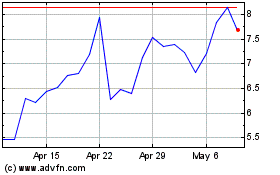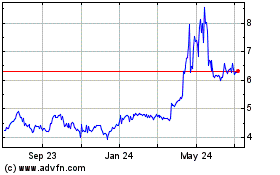Stock Market News for December 28, 2011 - Market News
December 28 2011 - 4:06AM
Zacks
Markets opted to take a pause after
a recent rally, as mixed economic data and a session featuring
light volumes meant benchmarks ended Tuesday’s session on a flat
note. Given the Christmas overhang, consolidated volumes remained
substantively low, and final minutes’ movement took the Dow
slightly lower to end its winning run of four consecutive trading
days.
The Dow Jones Industrial Average
(DJIA) slipped 2.6 points or 0.02% to finish the day at 12,291.35.
The Standard & Poor 500 (S&P 500) also remained almost
unchanged at 1,265.43, gaining 0.01%. The Nasdaq Composite Index
was up 0.3% and finished yesterday’s trading session at 2,625.20.
The fear-gauge CBOE Volatility Index (VIX) went up 5.7% to settle
at 21.91. Consolidated volumes on the New York Stock Exchange
(NYSE), NYSE Amex and Nasdaq, were roughly 3.59 billion shares,
which were significantly lower than the year's daily average of
almost 7.9 billion shares. For 50% of the advancing stocks on the
NYSE, 47% of the stocks traded lower. The remaining stocks were
left unchanged.
Since last week, investors had been
receiving Christmas gifts in the form of encouraging economic data.
Housing and the jobs markets, two of the key elements of the
economy, posted strong data last week. The jobs market showed
significant strength, as data from U.S. Department of Labor
provided investors with a welcome reprieve after initial claims
dropped to a three and half year low.
However, a 9.3% rise in housing
starts and building permits shooting up to its highest level since
March 2010 were slightly offset by home sales data from the
National Association Realtors (NAR) released on Wednesday.
Additionally, data on revised home sale counts of 2007, according
to which existing home sales were 14.3% worse than previously
reported came as a disappointment to investors last week. Monday’s
markets were also guided by economic data, which included a joint
release by the U.S. Census Bureau and the Department of Housing and
Urban Development according to which new home sales had increased
more than the consensus estimate.
It was the S&P/Case-Shiller
Home Price Index data, which took the sheen away from markets’
initial modest gains, as it reported a drop in home price in 19 of
the 20 cities. The report stated: “Data through October 2011,
released today by S&P Indices for its S&P/Case-Shiller Home
Price Indices, the leading measure of U.S. home prices, showed
decreases of 1.1% and 1.2% for the 10- and 20-City Composites in
October vs. September. Nineteen of the 20 cities covered by the
indices also saw home prices decrease over the month. The 10- and
20-City Composites posted annual returns of -3.0% and -3.4% versus
October 2010, respectively”.
Since these are a group of indexes
that track changes in home prices throughout the United States;
this data holds immense value for investors. A drop in home prices,
as reflected through the S&P/Case-Shiller Home Price Index
naturally had an adverse impact on markets. The PHLX Housing Sector
(HGX) was down 0.1% and stocks like KB Home (NYSE:KBH), DR Horton
Inc. (NYSE:DHI), Beazer Homes USA Inc. (NYSE:BZH), Comstock
Homebuilding Companies Inc. (NASDAQ:CHCI), Lennar Corp. (NYSE:LEN)
dropped 2.6%, 0.8%, 2.1%, 1.3% and 0.4%, respectively.
Earlier, strong consumer confidence
data helped stocks register modest gains. Consumer data is another
key indicator of the economy’s health. Investors received a boost
after the Commerce Department reported that U.S. consumer
confidence had increased to 64.5 in December from 55.2 in November.
The figure was also well ahead of the consensus projection of 59.3.
In the report released by The Conference Board, Lynn Franco,
Director of The Conference Board Consumer Research Center, stated:
"After two months of considerable gains, the Consumer Confidence
Index is now back to levels seen last spring (April 2011, 66.0).
Consumers’ assessment of current business and labor market
conditions improved again. Looking ahead, consumers are more
optimistic that business conditions, employment prospects, and
their financial situations will continue to get better”.
However, major retail stocks could
not garner strong gains. While stocks like J. C. Penney Company,
Inc. (NYSE:JCP), Bon-Ton Stores Inc. (NASDAQ:BONT) and Saks
Incorporated (NYSE:SKS) slipped 1.1%, 3.3% and 1.1%, respectively,
others like Macy's, Inc. (NYSE:M), Target Corp. (NYSE:TGT),
Dillard's Inc. (NYSE:DDS) and Nordstrom Inc. (NYSE:JWN) only
managed gains of 0.3%, 0.8%, 2.5% and 0.5%, respectively.
BON-TON STORES (BONT): Free Stock Analysis Report
BEAZER HOMES (BZH): Free Stock Analysis Report
COMSTOCK HMBLDG (CHCI): Free Stock Analysis Report
DILLARDS INC-A (DDS): Free Stock Analysis Report
D R HORTON INC (DHI): Free Stock Analysis Report
PENNEY (JC) INC (JCP): Free Stock Analysis Report
NORDSTROM INC (JWN): Free Stock Analysis Report
KB HOME (KBH): Free Stock Analysis Report
LENNAR CORP -A (LEN): Free Stock Analysis Report
MACYS INC (M): Free Stock Analysis Report
SAKS INC (SKS): Free Stock Analysis Report
TARGET CORP (TGT): Free Stock Analysis Report
To read this article on Zacks.com click here.
Zacks Investment Research
Comstock Holding Companies (NASDAQ:CHCI)
Historical Stock Chart
From Apr 2024 to May 2024

Comstock Holding Companies (NASDAQ:CHCI)
Historical Stock Chart
From May 2023 to May 2024
